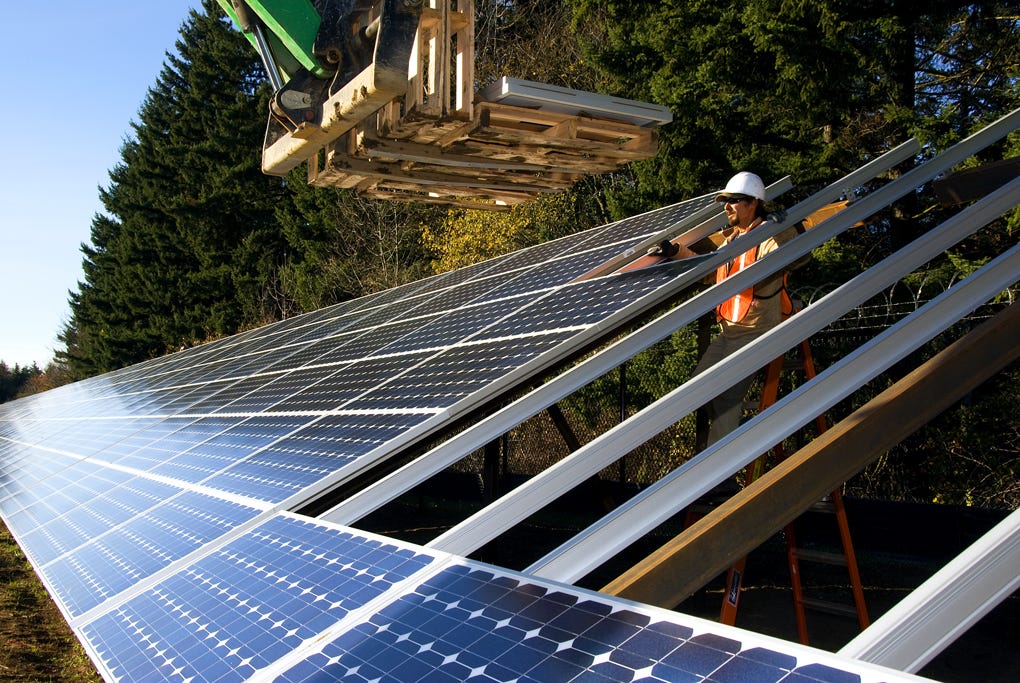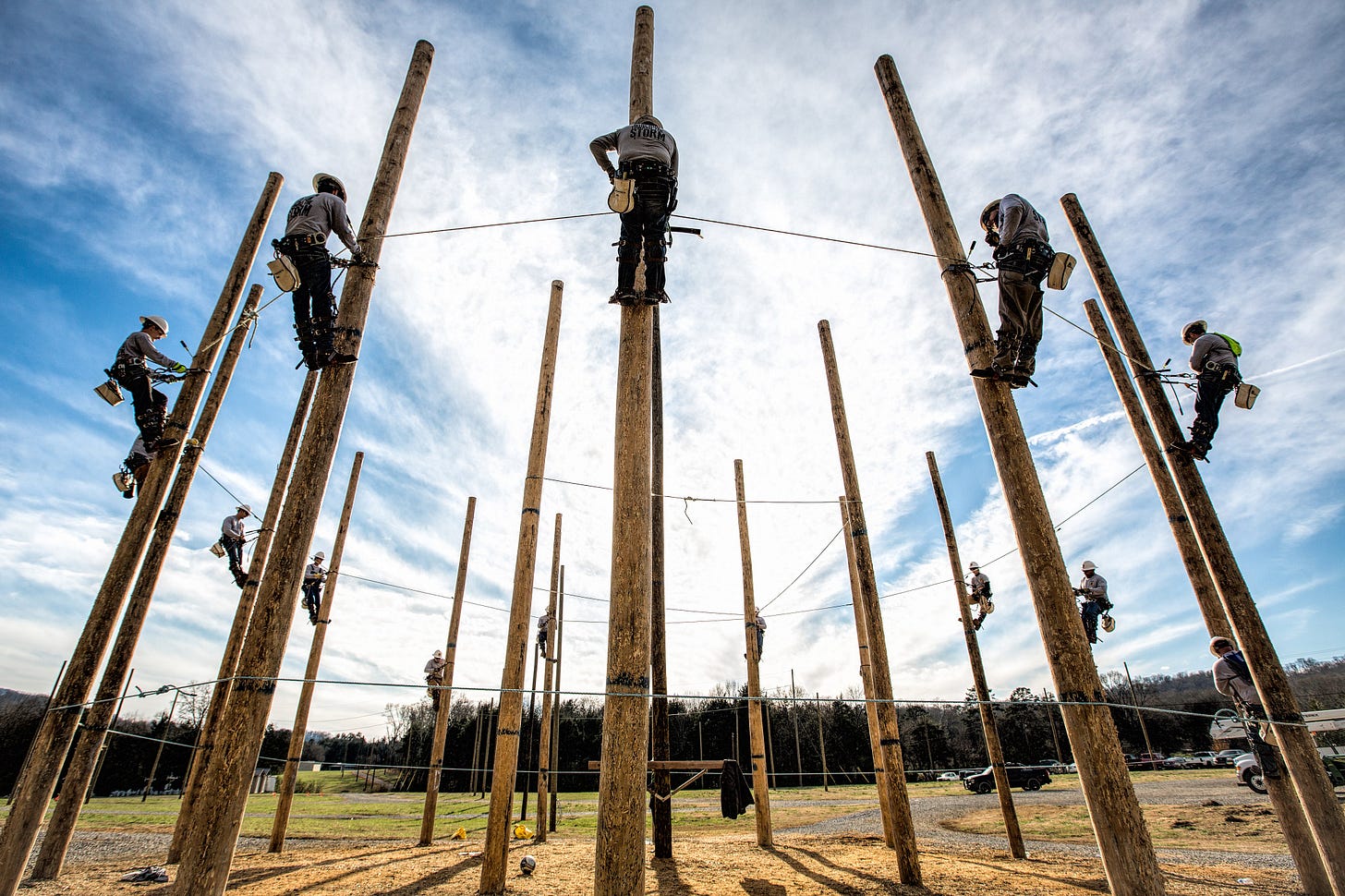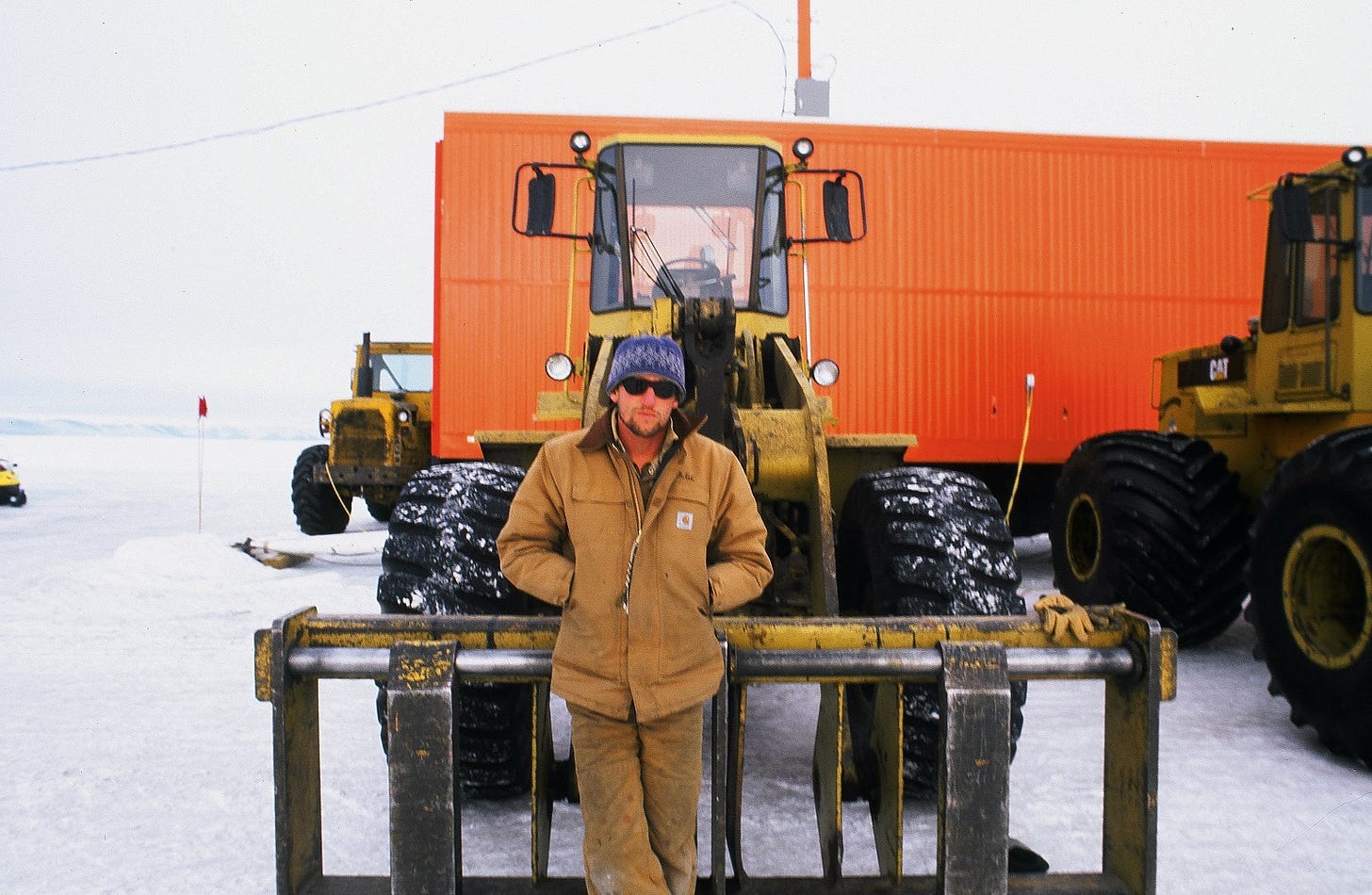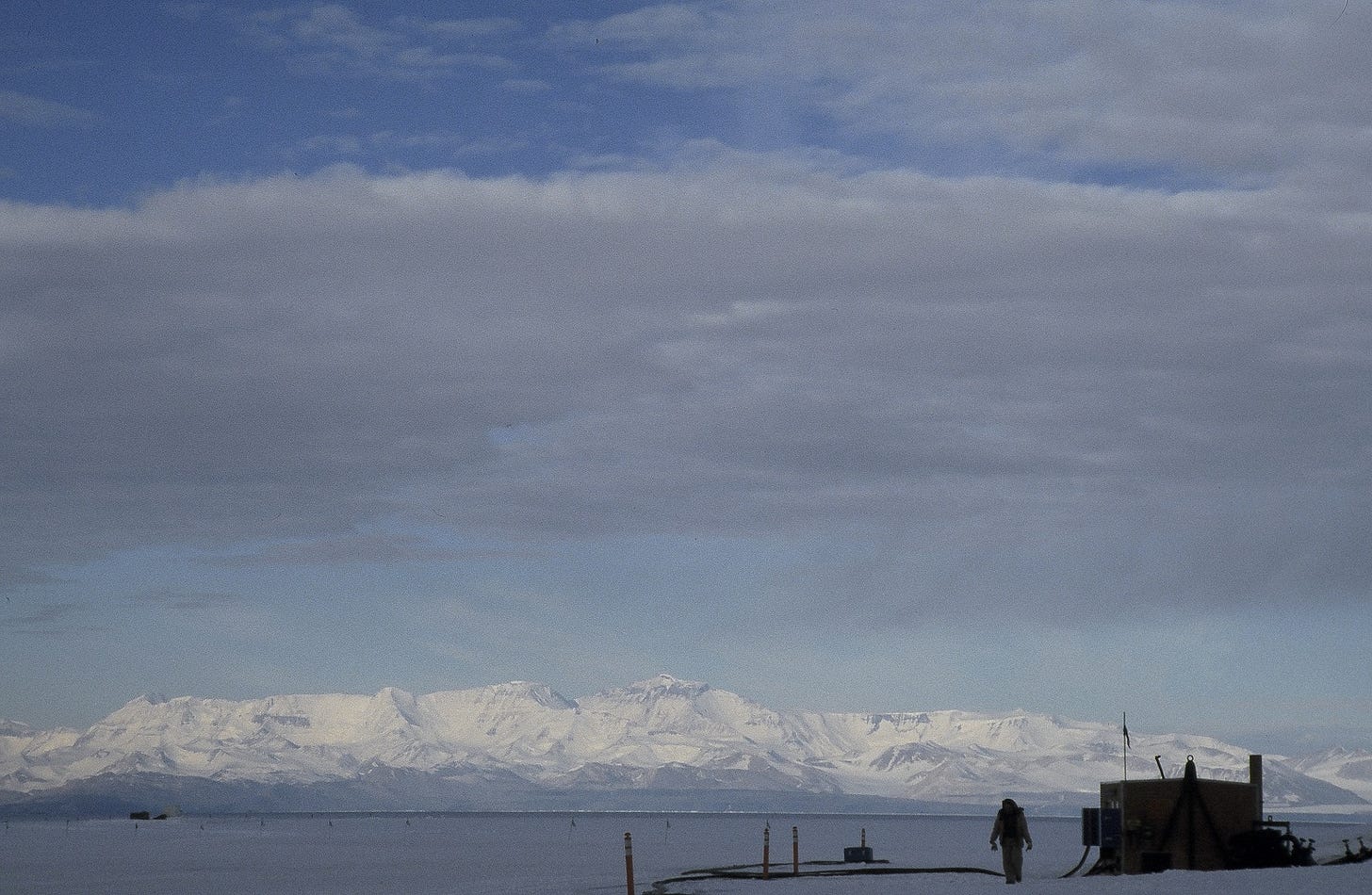
Hello everyone:
As always, please remember to scroll past the end of the essay to read some curated Anthropocene news.
Now on to this week’s writing:
We’re closing in on graduation time, and I have a few thoughts for students about their future. I’m thinking not just about the world they’re inheriting, but how they might want to work toward solutions.
I’m an unlikely person to give career advice. I majored in English, earned an MFA in Poetry, and have spent the subsequent decades creating a resume that might as well be written in crayon. I have never, not once, had a year-round full-time job. My savings have always been slim, but I have no debts. And I’ve been lucky and privileged enough to live well, travel far, spend a good amount of my life outdoors, grow some of my food, learn and teach important things, write two good books, have an amazing son, and fall in love with the perfect woman. (Don’t tell her I said that.)
I’ve been a writer and teacher, but I’ve also worked as a Waste Management Specialist, Cargo Handler, and Field Camp Supervisor. I’ve driven heavy equipment, mowed lawns, painted houses, and built runways with a snowmobile and a tractor.
It’s an odd life, but an examined one. It’s where I stand, anyway, as I offer advice on the working lives young people should be thinking about as they take responsibility for the next phase of the Anthropocene.
A 2022 study by the esteemed medical journal Lancet surveyed 10,000 youth (ages 16-25) in 10 countries and found that 83% understand that “people have failed to take care of the planet.” 75% think the future is frightening, largely because of the consequences of rapid warming. In the U.S., 46% of youth surveyed were either very or extremely worried. That number leaps to 75% if we include those who are moderately worried. These numbers are likely to climb in the next several years as the climate and biodiversity crises intensify.
The kids know what’s going on. And we know they know. The Sunrise Movement is a perfect example of that knowledge in action. They played a key role, for example, in turning out young green voters in the 2022 election. If you read their statement of principles, you arrive at #11:
Though our times are often dark and difficult, we know that sinking into despair is not an option. We choose to believe in ourselves and our movements, and make space for light and love in our lives. Changing the world is a joyful and fulfilling process, and we let that show.
In this spirit, then, how should a student now sailing into the heat wave of the future think about a career that helps change the world while also being joyful and fulfilling? There are more options than you might think, and many of them don’t require a college degree.
The Green Revolution Requires a Blue-Collar Revelation
The New Yorker has an interesting issue out now called “Bottlenecks,” with several articles highlighting some key climate solutions. David Owens’ piece, “The Great Electrician Shortage,” is about the need to fill the millions of trades jobs the U.S. needs to make the clean energy transition. He focuses on Connecticut, where technical colleges and other training programs are actually working to meet the challenge. It’s a rare bright spot in a country that is desperately behind the curve. The U.S. trades worker shortage is mind-boggling:
job openings in the construction industry averaged three hundred and ninety thousand a month in 2022, and the shortfall was made more ominous by the fact that roughly a quarter of existing workers are older than fifty-five.
Rewiring America, an influential nonprofit working for the electrification of the economy, estimates that we’ll need 80,000 new electricians per year for the next decade merely to replace those who are aging out or leaving the positions. More broadly, Rewiring America estimates that an all-out push to mobilize for a zero-carbon America by 2035 would create 25 million well-paid jobs over the next 15 years and 5 million sustained jobs by 2050. Part of that assessment includes one million more electricians to install solar panels, heat pumps, and electric charging stations for the millions of EVs coming to a driveway near you.
As journalist and veteran climate activist Bill McKibben told the Times, “If you know a young person who wants to do something that’s going to help the world and wants to make a good living at the same time, tell them to go become an electrician.” Or HVAC specialist, carpenter, pipefitter, machinist, or any of the other trades adjacent to the electrify-everything revolution that the Biden administration’s Inflation Reduction Act has kicked into high gear.
If we’re going to rebuild the economy, we’ll need a generation of builders.

The electrical grid needs a 21st century upgrade and must be at least tripled in size. Buildings of all types need to become more efficient and sustainable. Transportation networks must be reinvented. The economy needs to be made more circular, which means a generation of workers innovating new efficient manufacturing and recycling processes.
Hypothetically, I suppose, the U.S. could rapidly expand immigration quotas and train new arrivals to fill the millions of necessary construction jobs, but I don’t think that’s a politically-viable idea…
One essential step is to open up these jobs to women, who currently make up, for example, only 2% of the country’s electricians. Reasons to be Cheerful has a great article on how women are stepping into these roles, despite the longstanding gender imbalance. In the Connecticut public trades school system, young women “now make up roughly a quarter of the carpentry students, a fifth of the electrical students, a third of the masonry students, and a sixth of the plumbing and heating students.” The time is right for women looking to learn and apply these skills to the construction of a more sustainable society.
I’m not proposing that this generation of graduates have to sacrifice themselves for the greater good. I’m saying that becoming a hands-on builder of the new age is as smart a financial move as it is an ethically vital one. The median income for an electrician or plumber is around $63,000, though master electricians can make six-figure salaries. Owens, in the New Yorker, interviewed a plumbing contractor who made the financial analysis clear:
Those who skip college frequently do better, and not just at first. “One of my guys came to me from the same trade school I went to,” LeMieux told me. “He had a couple of friends who went to college, and when they got out they were two hundred thousand dollars in debt and didn’t have jobs, and he was already making enough to buy a nice new vehicle and a house. I pay him a good hourly wage, he has health insurance and a 401(k), and he gets holidays, vacation time, and personal days. And he will always work—always.”
The prospect of always having high-paying work should be a comfort to anyone looking for stability. But even if, like me, you want to live a more carefree wanderer’s life, having a well-paid set of skills you can apply when and where you choose – building homes or installing heat pumps, for example – will bankroll the lifestyle of your choice. (Weirdly, it turned out that writing poetry was not a well-paid skill.)
Trades jobs are hands-on jobs. Hands get dirty and tired, but – a few generations of office and tech workers notwithstanding – that’s what hands have been doing for the last million years. As plenty of observers have pointed out over the last couple decades, we’ve stopped telling good stories about ordinary hard work and replaced them with tales of office and cubicle life, as if the world runs on paperwork rather than on the labor done by tired and dirty hands.
There’s a lot of talk now about how this new generation wants to live online rather than doing hard work. However true or false that may be, if blue-collar work isn’t appealing, adults have only themselves to blame. We’ve let the tech and finance sectors identify as heroic rather than exposing them as the self-serving, extractive, unhealthy industries that they often are. We created the online attention-economy that sucks kids out of the real world. Worse, we have often elevated the status of a college education well beyond its practical benefits while simultaneously demoting technical education to second-tier status.
I heard a horror story a few years ago from a friend who teaches at a high school where, at an end-of-year full school gathering, the principal asked all the college-bound seniors to raise their hands. He led a cheer for them, but had little to say for the other graduates. This longstanding societal disregard for blue-collar work is ethically wrong, financially inaccurate, and strategically crazy. If we’re going to meet the new world that’s coming, it needs to change now.
Many of the smartest, most interesting people I know work with their hands. Some went to college, others didn’t. All of them are creative problem-solvers, adept and funny, patient and innovative.
It occurs to me that the cultural habit of dismissing trades work as less valuable than careers rooted in a college education is the same kind of high-minded ignorance that has led educated people to become blind to the community of life. We sit in our conference center, office, or home, diplomas on the wall, so unaware of the many fascinating intelligences in the landscape around us that we wonder whether we’re alone in the universe. At the same time, we’re unable to build, maintain, or fix any of the basic functions of the buildings we spend nearly all of our lives in.
There’s a deep and ancient satisfaction in having practical skills and in accomplishing hard work. If students can combine that satisfaction with the urge to build resilience and efficiency into a world preparing for climate change, it seems like a good plan for a well-paid and meaningful life.
If You Go to College, Study the Real World
I’m not opposed to college at all – in fact, I’m a fan of prolonged learning amid some parties and frisbee-throwing – but the American model has become increasingly irrational. Comparisons are complicated, but it’s worth noting that students in Europe (even American students) can attend public universities for free (or with a small fee) while students in the U.S. hit the streets with tens or hundreds of thousands of dollars in debt. For a fun analysis of whether a college degree is worth it, check out this informative comedy bit from the Daily Show’s Roy Wood, Jr.
Cost aside, I think it’s worth saying that you can certainly get a liberal arts or science degree before becoming an electrician or carpenter. Why not study, say, botany and art, or physics and conservation biology, to give yourself something to think about while working with your hands?
I have long wondered why some mainstream colleges and universities haven’t developed hybrid programs that offered practical skills to typical college students and a full array of high-level academic courses to students who know they want to work with their hands. I’m afraid that the lack of such options is the result of the bias against traditional labor. It would be better for students and society if academic and trades training existed side-by-side. I’d love to meet the student who was double-majoring in art history and plumbing.
Colleges and universities are facing a steep drop-off in student numbers in the years ahead, so many of them will have to rethink their role in society if they want to persist as institutions. Why not make education affordable by stripping out extraneous campus functions and parallel the academic program with a full array of training and certification programs? For that matter, why not start this intensive dual training in high school?
But I digress. My main point for students heading off to college is that it’s vital that, to the greatest extent possible, they study the real world and its needs, whether through ecology, natural history, ocean sciences, climate physics, marine biology, population dynamics, geology, conservation genetics, land use and public policy, etc. We desperately need more ecologists and environment-minded strategists, whether in labs, on ships, in the woods, in a government office, or at a desk writing stories that help create more ecologists and environment-minded strategists.
The world is heating up, the tapestry of life is unraveling, and our constant blind push to break planetary boundaries reflects a fundamental ignorance of how the world works. Even if a student is an English or History major, they should contextualize those studies within the fate of life on Earth. Existing in the Anthropocene means that students are not merely living and telling the story of the world; they’re determining it.
Or, if their academic desires send them headlong toward the tech or finance sectors, students need to look for ways to shape that knowledge in ways that will build a better world rather than supporting its destruction. Tech startups could crowdfund conservation work, and finance can be made carbon-free. And don’t get me started on economics: any class in that department that preaches the insane gospel of constant growth isn’t worth a student’s time, unless they want to stand up as an activist and explain that growth is the method to our madness.
Speaking of growth, today’s students don’t really have the option of leisurely growing up. They’re aware that we have left them with a litany of obligations and responsibilities.
My wandering life, however cute, has been part of the problem. Four of my eight years in Antarctica were spent dispensing fossil fuels in the most pristine environment on Earth. I’ve flown around the planet to hike up one mountain or another. I’ve warmed myself by burning things – wood, propane, oil – all my life without properly accounting for the impacts. My life has been pretty low-impact in other ways, but only compared to other Americans. This scribbling may be useful (putting my poetry degree to work!), but only to a point. We’re all trapped by, yet complicit in, an unsustainable civilization.
Until we change it.
The editors of the New Yorker’s “Bottlenecks” issue describe the climate solutions it highlights this way: “Their goal is to act quickly, in useful places: to find solutions that make other solutions possible.” Today’s young students and graduates need to see themselves and their careers the same way.
The good news is that, unlike most of us in previous generations, they already do. That’s why so many of them are worried. How they choose and shape their education and careers – in joyful and fulfilling ways, I hope – will also choose and shape our collective future. To be clear, by “our collective future” I mean that of their generation, us, and the community of life that is struggling to persist intact as we determine whether or not to pull back from the depths of much, much worse planetary disruption.
Of course, there are many millions of jobs adjacent to the ones I mention here, from lab assistants to lawyers and from schedulers to school administrators. In the scenario described by Rewiring America, in which the U.S. aggressively pursues a sane energy future, those jobs will be pulled along in the same direction, away from fossil-fueled destruction and toward a difficult, but better, future.
As long as they’re part of the solution rather than the problem, the kids will be alright. In that sense, maybe it doesn’t matter so much what you do if your life and work are devoted to taking care of the planet.
I’ve just scratched the surface here, and you will have opinions. I’d love to hear them.
Thanks for sticking with me.
In other Anthropocene news:
From the Guardian, good news on a major increase in dam removals in Europe, including a big one the WWF took down in Ukraine, opening up 27 km of river habitat for the first time in 120 years. This is a nice follow-up to last week’s news from Yale e360 on the end of the big dam era around the world.
From the great David Quammen in an opinion piece for the Times, a deeply disturbing but necessary read on the spread of avian influenza in wild bird populations. This is a pandemic that is mostly invisible to us, but it shouldn’t be. Why? In part because it could someday become a pandemic for us too, but mostly because we – with our tens of billions of poultry birds – are responsible for it.
From Anthropocene, a nuanced assessment of the pros and cons of the U.S. building its own solar panel production capacity and slapping tariffs on Chinese panels. The answer isn’t as simple as you might think.
From Grist, another article on the repercussions of the Supreme Court’s important decision not to allow the fossil-fuel companies to squelch the increasing number of lawsuits from cities and states dealing with climate-related expenses. The logic of the suits is pretty straightforward: the industry has long known the consequences of its actions but nonetheless lied to the public for decades. The prospect now for these cases is looking much, much better for the cities and states. Assuming the industry doesn’t find other means to end the suits, they’ll be fighting dozens of cases in different jurisdictions, often in front of a jury, trying to explain away the long paper trail of lies.
From DeSmog, an investigative journalism site working “to clear the PR pollution that is clouding the science and solutions to climate change,” how the meat industry is using slick PR and marketing to try to counter the growing common knowledge that meat – especially beef and dairy – is a major contributor to the climate crisis.
From Inside Climate News, environmental groups are pressuring the Federal Trade Commission to put out clear and responsible guidance on plastic waste recycling. Plastic recycling is largely a myth in the U.S., and the “chasing arrows” symbol we all know amounts to greenwashing. Worse, there is particular concern about the plastic industry’s push for “chemical recycling” and “advanced recycling,” which are carbon-intensive, toxic processes that produce very little recycled plastic.
From the Rewiring America newsletter, a reminder that the best AC is a heat pump, for both financial and environmental reasons.








This needs to be published in every newspaper in the country as an editorial. Perfectly said!
I didn't see any suggestion of Lifestyle change. It seems to be low on the radar and somewhat out of favor as a prescription to change. Children inherit the beliefs and patterns of their parents to a large extent. What are the ramifications of the Electric future? What are the costs? What is the impact of one wind turbine on the Environment? Would you like one within a 1/2 mile of your home.. one mile .. ten miles...? What is the impact? Solar arrays? How big how many? Who cleans them up when the owners
go bankrupt because of a new technology shift? I suggest the children attempt to imagine themselves as new Indigenous people. I suggest they get to know a 5 mile radius of their home as their walking territory. Who would you meet? What connections created? What role can they envision over a lifetime would you like to be part of history? (we all are) Stay local. you will create the world you dream of.. If it is a good dream.